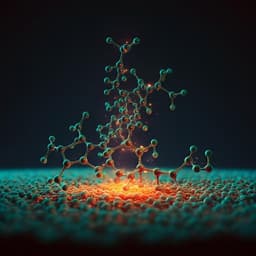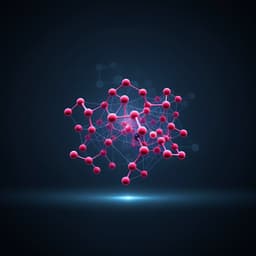
Chemistry
A concise and scalable chemoenzymatic synthesis of prostaglandins
Y. Yin, J. Wang, et al.
This innovative report reveals a streamlined chemoenzymatic method for synthesizing prostaglandins in just 5 to 7 steps. With a focus on high enantioselectivity and economical lipid chain incorporation, this research led by Yunpeng Yin, Jinxin Wang, and Jian Li promises to make prostaglandin-related drugs more accessible and affordable.
~3 min • Beginner • English
Introduction
Natural prostaglandins (PGs) are a family of lipid compounds generated from arachidonic acid by cyclooxygenase (COX). Due to their unique biological properties and medicinal value, prostaglandins have gained extensive attention from medicinal chemists. However, natural PGs often exhibit poor chemical stability, rapid in vivo metabolism, and side effects, limiting direct therapeutic use. Medicinal chemists have therefore developed structurally diverse PG derivatives and analogs to address these issues, leading to more than 20 approved PG-class drugs with significant market demand. Consequently, there is a strong need for concise and efficient synthetic routes to prostaglandins and related drugs to meet demand, reduce costs, and facilitate new drug development.
Literature Review
Following the landmark synthesis of PGF2α by Corey and co-workers, many efficient approaches using Corey lactone as a key intermediate were developed for diverse prostaglandins and analogues. The Chen group reported the shortest asymmetric synthesis of Corey lactone in four steps from commercial materials. Numerous alternative strategies that bypass Corey lactone have been established by teams including Stork, Woodward, Nicolaou, Danishefsky, Carreira, Noyori, Aggarwal, and Zhang. Representative efficient strategies include: (1) Zhang’s use of noble metal catalysis (Ir, Rh, Pd, Ru) to enable scalable prostaglandin synthesis; and (2) Aggarwal’s organocatalytic approach completing prostaglandin synthesis in seven steps. Radical-based disconnections (Baran) and Baeyer–Villiger-based strategies (Chen) inspired retrosynthetic analysis in this work. Chen’s dichloro precursor led to an eight-step route to PGF2α, while the Baran group relied on Corey lactone, which itself requires at least four steps from cost-effective starting materials. Over the past decade, radical reactions have become prominent for C–C formation, complementing polar and pericyclic logic, and chemoenzymatic strategies have been increasingly used for complex molecule synthesis. Renata’s merger of chemoenzymatic and radical retrosynthesis simplified meroterpenoid syntheses. These developments motivate a design combining radical and enzymatic methods to improve prostaglandin synthesis efficiency.
Methodology
Retrosynthetic strategy: The cis double bonds of prostaglandins are planned via classic Wittig reactions (polar disconnection), while the trans-olefin side chains are introduced using nickel-catalyzed reductive coupling (radical approach). A bromohydrin (compound 8) is designed as a radical equivalent of Corey lactone, accessible from chiral lactone 9 via NBS/H2O. Two complementary routes to chiral lactone 9 were developed.
1) In vitro chemoenzymatic route plus Johnson–Claisen rearrangement: Commercial achiral diol 12 ($13/g) undergoes lipase-mediated desymmetrization to afford mono-acetate 11 in 95% ee. Johnson–Claisen rearrangement using triethyl orthoacetate with o-nitrophenol, followed by K2CO3/MeOH in one pot, provides lactone 9. This route produced 13.2 g of 9 in one run and reduces steps versus literature, but relies on costly starting materials and prolonged high-temperature heating, complicating further scale-up.
2) In vivo enzymatic Baeyer–Villiger oxidation (oxidative resolution): More affordable racemic cyclobutanone 10 ($2.3/g) is converted using CHMO (CHMOrhodol) with NADPH regeneration. An E. coli strain co-expressing CHMOrhodol and a regeneration enzyme was constructed. Initial GDH-based regeneration increased product titers to 9.3 g/L, but GDH regeneration lagged behind CHMO activity. Switching to phosphite dehydrogenase Opt-13 enabled complete conversion at 40 mM and 83 mM substrate loadings; higher Na2HPO3 concentrations diminished activity. Scale-up at 83 mM with full conversion allowed preparation of >100 g combined lactones (9 and 14). Across systems and scales, ee values were consistent: 9 at 95% ee and 14 at 97% ee; isolated yields for the scaled runs were ca. 45% for each lactone.
Bromohydrin formation (8): Literature NBS/H2O conditions often gave undesired diastereomers. Inspired by prior work, DMSO was used as a Lewis base to modulate bromonium ion behavior, reversing bromonium direction and improving selectivity. Co-solvent screening showed CHCl3/DMSO (9:1) with NBS and H2O (2.0 equiv each) for 3 h gave the highest yield and desired product ratio; bromohydrin 8 was later obtained by recrystallization in 86% yield and >99% ee on scale.
Nickel-catalyzed reductive cross-coupling of 8 with ω-chain electrophiles: Guided by Weix/Gong precedents, initial conditions (NiBr2·glyme, Zn, MgCl2, DMA) with pyridine furnished 49% yield but generated epoxide 17 due to weakly basic conditions. Using a catalytic bidentate ligand (18) increased epoxide formation. Temporary in situ OH protection with N-(trimethylsilyl)imidazole (TSIM, 1.1 equiv) suppressed epoxide; this gave 52% coupling yield alongside 37% elimination product. Adding pyridine (1 equiv) or ligand 18 (15 mol%) with TSIM increased coupling yields to above 83%, enabling installation of three different prostaglandin side chains in high yields. For cost reasons (ligand price vs nickel source), the pyridine/TSIM conditions were chosen for scale-up. Aromatic and heteroaromatic substrates also coupled efficiently using ligand 19.
Completion of target syntheses: After assembling the chiral skeleton and installing the first side chain, remaining steps included lactone reduction and Wittig olefinations to set cis double bonds. On 10 g scale, the bromohydroxylation and Ni-catalyzed coupling maintained performance; coupling yield was 73% at this scale, providing 12 g of intermediate 7 in one batch. From 14.2 g of lactone 9, 10.6 g of prostaglandin F2α was obtained in five steps. Analog syntheses (each starting from 1.6 g of 9) delivered fluprostenol (2.13 g), bimatoprost (1.89 g), cloprostenol (1.82 g), and latanoprost (1.29 g). For latanoprost, Raney nickel catalyzed hydrogenation of the double bond in 99% yield, avoiding noble metals.
Representative biocatalytic oxidation procedure: E. coli BL21(DE3) co-expressing CHMOrhodol (pET-22b(+)) and Opt-13 (PRSF) were grown, induced (riboflavin 1.0 μM, IPTG 0.5 mM), harvested, and resuspended in KPi buffer (50 mM, pH 8.0) to OD600=10. Ketone 10 (4.5 g in DMSO), Na2NADP·4H2O, and Na2HPO3·5H2O were added and shaken at 25 °C for 20 h; extraction afforded a 1:1 mixture of lactones 9 and 14.
Key Findings
- Developed a concise chemoenzymatic route to prostaglandins completed in 5–7 steps; PGF2α synthesized in five steps on decagram scale.
- Established bromohydrin 8 as a radical equivalent of Corey lactone, prepared from chiral lactone 9 in two steps; bromohydrin recrystallization furnished 86% yield and >99% ee on scale.
- Two complementary routes to chiral lactone 9: (i) lipase desymmetrization of diol 12 to 11 (95% ee) followed by Johnson–Claisen rearrangement to 9 (13.2 g in one run), though less scalable due to cost and high-temperature requirements; (ii) in vivo enzymatic Baeyer–Villiger oxidation of rac-10 using CHMOrhodol with Opt-13 NADPH regeneration achieving complete conversion at 40–83 mM, enabling >100 g preparation; typical ee: 9 at 95% ee, 14 at 97% ee; scaled isolated yields ~45% for each lactone.
- Bromohydrin formation optimized using NBS/H2O in CHCl3/DMSO (9:1), delivering the highest yield (up to 74%) and desired diastereoselectivity.
- Ni-catalyzed reductive coupling of bromohydrin 8 with ω-chains: baseline 49% yield improved to >83% by in situ OH protection with TSIM (1.1 equiv) plus pyridine (1 equiv) or ligand 18 (15 mol%); elimination and epoxide byproducts were minimized under optimized conditions. On 10 g scale, coupling proceeded in 73% yield to give 12 g of product 7 in one batch.
- Completed 10 g-scale synthesis of PGF2α: 10.6 g isolated from 14.2 g of 9. Gram-scale syntheses of fluprostenol (2.13 g), bimatoprost (1.89 g), cloprostenol (1.82 g), and latanoprost (1.29 g) from 1.6 g of 9 each; Raney Ni hydrogenation for latanoprost gave 99% yield.
- The overall route uses cost-effective starting materials and avoids noble metals, offering strong potential for industrial application and reduced drug cost.
Discussion
This work merges chemoenzymatic and radical-based retrosynthetic logic to deliver a scalable, enantioselective, and cost-effective synthesis of prostaglandins. The key conceptual advance is replacing Corey lactone with a bromohydrin radical equivalent (8) accessed in two steps from chiral lactone 9, enabling rapid installation of trans-olefin side chains via nickel-catalyzed reductive coupling, and cis-alkenes via Wittig olefination. Two orthogonal approaches to the chiral core (Johnson–Claisen vs in vivo Baeyer–Villiger) increase practicality and scalability, with the enzymatic oxidation route enabling >100 g preparation at high ee. Optimized bromohydrin formation using DMSO-modulated bromonium chemistry and in situ hydroxyl protection during Ni-catalyzed coupling were crucial to suppress side reactions and achieve high yields, including on multigram scales. The concise route (as few as five steps to PGF2α) and avoidance of noble metals underscore the relevance of this strategy for manufacturing prostaglandin drugs and facilitating access to analogues.
Conclusion
The study delivers one of the shortest, scalable routes to prostaglandins by integrating enzymatic Baeyer–Villiger oxidation or lipase/Johnson–Claisen strategies for constructing the chiral cyclopentane core with radical cross-electrophile couplings and classical Wittig reactions for side-chain assembly. The key intermediate, bromohydrin 8, serves as a practical radical equivalent of Corey lactone, enabling streamlined assembly and gram-to-decagram scale syntheses of PGF2α and several analogues. The approach is cost-effective, exhibits high enantioselectivity, and avoids noble metals, highlighting strong potential for industrial adoption and broader access to prostaglandin analogues.
Limitations
- The Johnson–Claisen route requires relatively expensive starting materials and prolonged high-temperature heating, limiting its scalability.
- In vivo biotransformation, while efficient, may be challenging to implement in traditional or medicinal chemistry laboratories without biocatalysis infrastructure.
- High concentrations of sodium phosphite used for NADPH regeneration can sharply reduce enzymatic activity at elevated substrate loadings, constraining further concentration scale-up.
- The enzymatic Baeyer–Villiger route provided moderate isolated yields (~45%) of lactones 9 and 14 upon scale-up, despite complete conversion at certain concentrations.
- Initial bromohydrin formation under literature conditions favored undesired diastereomers; optimization was required to achieve the desired selectivity.
- Nickel-catalyzed reductive coupling yields decreased upon scale-up (to ~73% at 10 g scale), indicating some scale sensitivity.
Related Publications
Explore these studies to deepen your understanding of the subject.







